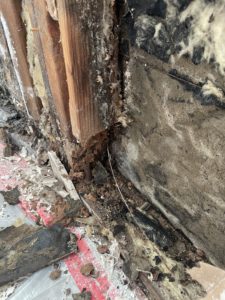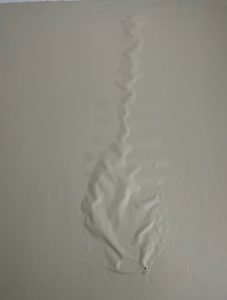Following the recent storms and flooding that have affected communities across California, the California Governor’s Office of Emergency Services (Cal OES) would like to remind everyone of the steps they can take to protect themselves and their families from post-storm related hazards.
Mold can be found in places that have experienced extreme amounts of water, hiding in walls, carpets, furniture, or other places that experienced severe flooding.

Internal damage to a structure from the 2022/23 Winter Storm in Sacramento County.
Although mold is common, it is treatable and preventable by following the steps below.
Flood Clean Up and Mold Prevention
Before starting any cleanup activities in the home after a flood, take pictures and videos of damage to the home and belongings to provide your insurance company. After taking photos, safely throw away damaged items that pose a health risk, so that the cleanup process can start.
Then, cleaning up any standing water or debris first. Use caution when removing standing water from your home. For more information on removing standing water check out: Flooded Homes: Removing Standing Water & Mucking Out – YouTube
According to the California Department of Public Health, if these items have been damaged by flooding, try to dry them out first if there is no visible mold present. If mold is visible, the below items should be thrown out immediately.
- Carpet
- Drywall
- Ceiling tile
- Fabric
- Foam
- Cardboard
- Paper
- Particle board
“Drying your home and removing water-damaged items is the most important step for preventing mold. Mold growth can be assumed if items have been in contact with flood water for more than 48 hours. Mold growth on hard surfaces with a bleach solution but the key is getting those water damaged items out of the home and drying the home as soon as possible. Contact your local environmental health department for guidance on mold remediation” says Jason Wilken, Epidemiology Field Officer at the California Department of Public Health.
After a flood, drying your home and removing water-damaged items is the most important step for preventing mold. Wear personal protective equipment such as gloves, boots, and goggles to dispose of moldy belongings and remove mold growth on hard surfaces like floors, countertops, sinks, and dishes, with a mix of 1 cup bleach in 1 gallon of water.

This photo shows what water damage can look like in your wall; it is a result of the 2022/23 Winter Storm in Sacramento County
How to disinfect hard surfaces touched by flood water:
-
-
-
- Wash with soap and warm, clean water
-
-
- Rinse with clean water
- Wipe surfaces with bleach water
- Don’t rinse, let the surface air dry
- Never mix ammonia and bleach
For more information, contact your local environmental health department for guidance on mold remediation.
Mold Exposure Symptoms
Exposure to mold can cause flu like symptoms, be aware if your family has:
- Sneezing
- Runny or stuffy nose
- Cough
- Itchy throat or eyes
- Asthma attacks in those who already have asthma
Repeated or long-term exposure to mold can increase a person’s sensitivity and allergy.
Resources
For more information please visit:
Cal OES: Floodwater Safety Tips
CDPH: Mold or Moisture in My Home: What Do I Do?
